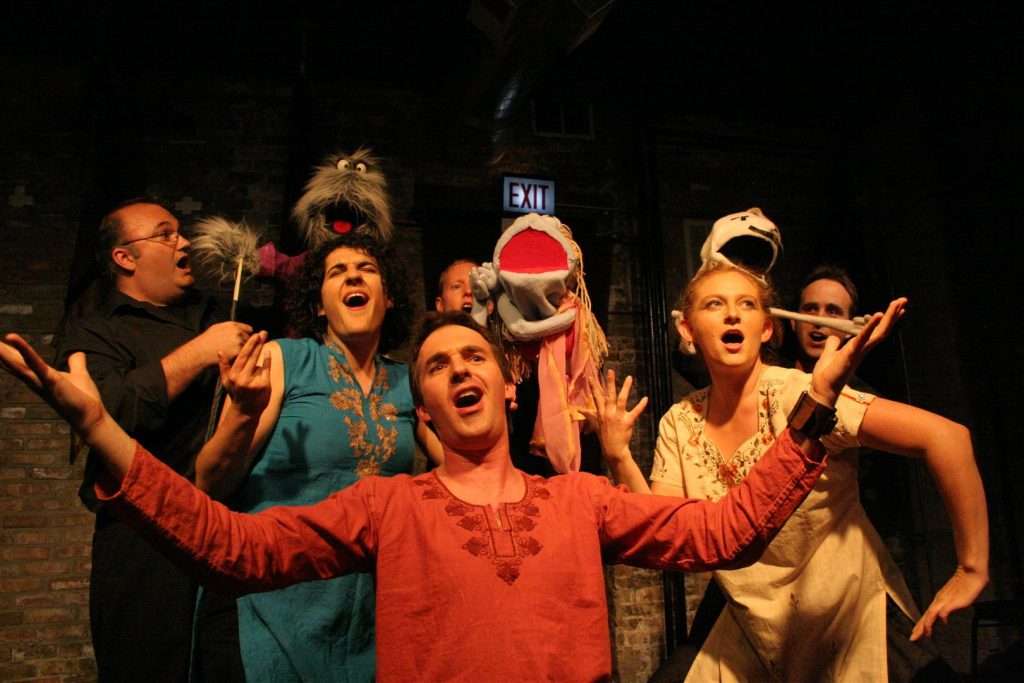Consider trying these as part of a training for teen leaders (to help them bond as a team), or as a fun icebreaker-type activity at a café before the presentation starts.
Crazy 8s
Players form a circle. In unison, everyone lifts the right hand, shakes it quickly, and counts to 8. They repeat this with the left hand, then the right foot (kicking it in the air while balancing on the left) and finally with the left foot. Everyone immediately repeats the pattern, except this time the players only count up to 7. In each round, the players count up to one less number, until everyone is quickly waving their entire body shouting “1! 1! 1! 1!” Then everybody cheers.
Note: Players are (often) encouraged to make and momentarily hold eye contact with each other during the course of the exercise.
Zip Zap Zop
Invite students to stand in a circle. Ask the group to repeat the words “Zip, Zap, Zop” three or four times, all together. Introduce the activity: Imagine that I have a bolt of energy in my hands. To start the game, I will send the bolt out of energy out of my body with a strong forward motion straight to someone else in the circle (use hands, body, eyes, and voice to make contact across the circle) and say, “Zip.” Explain that the next person takes the energy and passes it immediately to someone else saying “Zap.” That person passes it on to another participant with a “Zop.” The game continues and the “Zip, Zap, Zop” sequence is repeated as the energy moves around the circle. Encourage all plays to use their whole body to send energy and to make eye contact. They can send the energy to whomever they want but the goal is to include all players. Practice the game. If there is a mistake, encourage students to simply resume playing without discussion. The group challenge is to go very quickly and stay consistent in rhythm; if students struggle, pause the game, discuss strategy and try again.
Pass the Motion
All players in a circle. The leader explains that the group will be passing energy around the circle with claps. The leader demonstrates with a person next to them by asking them to make eye contact with them and then clapping with him/her at the same time. The leader then directs that person to passing the energy or the clap, to the person next to them. That person then turns to the person next to them and does the same thing. This continues around the circle. This establishes a solid rhythm to know when to clap. The clap goes in the same direction around the circle. Once the group has that down solid, introduce the concept of the double clap. If someone passes the clap to you, you can clap again and then the clap goes in the opposite direction. Anyone can choose to clap twice and all players need to be ready to pass it off or receive it again to pass back.
Good for: fun, group dynamics, bringing up the energy, getting out of your head.
Zoom/ Race Track
All players in a circle. The leader explains that the group will imitate a race track by sending an imaginary car around the circle by each player passing a clap to the next person saying the word “zoom”. Zoom travels in a circle. After that is established, the Leader introduces the concept of “brakes” where the player makes a screeching noise and holds up both hands to the player that just passed zoom to them. This switches the circle in the other direction with “zoom” going the other way. After that is establishes, the Leader introduces the concept of “bump” where if a player says the word “bump” while motioning a bump with their hands, it will skip the person next to the person who said “bump” and continue the “zoom” going in a circle. Once that is established, introduce “pass the canyon” where the energy can be sent across the circle to another person. Pass the canyon is initiated by someone saying “yee haw!” and with their arm motioning across the circle. Zoom then continues with the person who receives the “pass the canyon” gesture. Once that is established, introduce the “oil slick” whereby a player can shouts out “oil slick” at their turn and all the players run in the middle, scramble and reorganize a new circle. The player that said “oil slick” will resume the zoom. Take these one at a time starting with zoom, then brakes, then bump, then pass the canyon, then oil slick.
Good for: fun, warming up, group mind, thinking on your feet, flexibility, getting energy up and letting go.
Pass the Object
All players in a circle. One person mimes holding an invisible object in their hands, interacting with it accordingly so that it’s clear to others what the object is. After miming the object for a moment, they should pass it on to the next person, who reacts accordingly when they take it. They can interact with the object for a few seconds and then pass it on to the next person, or they can morph the object into something else before passing it on. When the group gets comfortable with the activity, they can start to pass and receive objects in more creative ways (e.g., throwing across the circle rather than passing to a neighbor).
Good for: fun, warming up, agreement, group dynamics.
What Are You Doing?
Begin with two people up. The rest of the group is ready to enter. The first person begins by pantomiming a common activity (brushing teeth, hair, washing hands, etc). The second player asks, “What are you doing?” The first person instead of saying what they are doing, will say a different activity. The second player now has to begin doing the new activity. Once the new person begins doing the new activity, the first person asks, “What are you doing?”. This continues back and forth until someone messes up. A new player jumps in and replaces them. The object is to get this going quickly back and forth so no overthinking is allowed! The leader explains the game and facilitates the people leaving and entering the game based on how the game is going.
Good for: encouraging flexibility, getting into the body and out of the head, embracing change as well as practicing gesturing, facial expressions and enthusiasm.
Yes…And…
All payers in a circle. We will tell a story using yes..and….
Rules: Never deny your fellow actor. Instead, you should be willing and able to accept the ideas the character conveys. Then, you should add to the scene. This improv principle is known as “Yes And.” Here’s how it works:
At the beginning of the scene, Character #1 will begin by establishing setting and plot.
Character #1: What a hot and miserable day to be a ranch hand!
Following the “Yes And” method, Character #2 will accept the premise and add onto the situation.
Character #2: Yep and the boss said we don’t get no water until this fence is mended.
Character #1: Yes and ain’t he the meanest boss we’ve ever worked for?
Character #2: Yep and it’s made me think about leaving behind this cowboy life and headin’ off for San Francisco.
Now, the scene could continue on indefinitely with the actors simply agreeing with one another. However, it’s best to develop conflict as well. Even though the performers constantly affirm each response doesn’t mean they can’t argue.
Good for: co-creating, taking care of your partner, thinking on your feet, listening, letting go of your own ideas, and making something out of nothing
One Word at a Time Expert
2 players and a leader/interviewer. The two players are an expert on a subject chosen by the audience. The expert is really one person with 2 heads, and answers to the interviewer’s question are provided word by word, one word at a time per player. After 2 players jump up, the leader will ask the audience “What is this person’s expertise?” Then the leader encourages the experts to begin taking the audiences’ questions. Three or four questions per pair is suitable.
Good for: co-creating, taking care of your partner, thinking on your feet, listening, letting go of your own ideas, and making something out of nothing.
Party Quirks
3-4 Players. One player plays a character that is having a party. The other players will be the guests. Ask the player who is playing the host to leave the room. The audience provides the players who are the guests with quirks. A quirk could be an ailment, a radical belief or obsession, a preoccupation or love of something. Of course the host does not know the quirks of the guests. The host’s task is to guess the guests quirks, based on hints the guests offer.
The Leader will send the host out of the room and define the guests’ quirks. Once that is established, invite the host back into the room. Begin the game by having the host “on stage” getting ready for the party. The first guest will enter the space. The host will invite them in and they improvise as if they are people at a party. The guest provides subtle hints to the quirk to the host. Soon, the next guest enters the party and so on. When the host thinks s/he knows the quirk, s/he mentions it within the context of the scene and if s/he is correct, that guest can exit the scene. The games is over as soon as the host has guessed all guests’ quirks. If the host appears confused or the game is going on too long, the Leader can ask the host “Do you know what their quirk is?”. If they don’t, that is a cue to the actors to make their offerings more obvious.
Good for: learning how to take the focus off the self, listening, incorporating ideas, problem-solving on the spot and showing rather than telling.
One Word Story or One Sentence Story
Everyone in a circle. Start by getting a suggestion for a title of a story that has never been told. One at a time each person will add a word/sentence to create a cohesive story. Prior to beginning, the leader should describe the game and discuss the basics of story telling. The story should be at a 3rd or 4th grade level. Remind them of the elements of storytelling- we need a set up, (which includes a main character), a struggle or conflict and a resolution. The story should relate to the title.
Good for: listening skills, building on what was said, thinking on your feet, letting go of your own ideas and practicing the elements of telling a good story.
The Ad Campaign
A group of 5-12 players has five minutes to create an ad campaign for an ordinary product with an unusual quality (or advertise your research lab to incoming graduate students). For example, a cereal that plays music when milk is poured on it. The group must come up with a name for the product, a package design, a slogan, a spokesperson and a jingle to create an entire marketing strategy and finished commercial. Every idea is accepted enthusiastically and remembered. Each step is built off the previous step. Players should respond enthusiastically to every idea by over-accepting, screaming “Yes!” “Terrific idea!” “Great!” etc. This over acceptance, especially of the stupid ideas makes this game all the more fun. The leader will explain the game as stated here and then get the name of the product from the group. The leader then acts as the president of the company “We’ve been tasked with creating a campaign for our new xyz product. We need to come up with a slogan for this product, what are your ideas?” Let the group jump in and offer ideas spontaneously. Cue them for the package design, jingle, spokesperson etc. until the campaign is complete.
After a 2 or 3 crazy products, start doing the same thing but creating an ad campaign for your café. Start with the title and then players may add to it using “yes, and…”. Remember, there are no wrong answers or things that are too crazy. Make the most outrageous ad you can (who knows, you may get some good ideas for activities to do at your café).
Good for: agreeing while taking risks, getting out of the perfectionistic thinking, building agreement with a group, team building and generating ideas.
Press Conference (helpful in developing interesting analogies and new ways of thinking about the research topic)
One scientist will be interviewed by the others in the room. The ‘journalists’ in the audience will ask the scientist silly questions about their research.
If your research topic were a flavor of ice cream, what would it be?
If you were the CEO of a company, what would your company be called?
If your research were animated, what would the main character look like?
What planet would your research be best suited to?
???
One player leaves the room, while the audience provides the name of a famous or historical person. The `absent` player will give a press conference, but he does not know who s/he is. The other players are journalists, whose questions should provide indications to who the mystery guest might be. Game ends when our player guesses who s/he is. The leader will ask who wants to play and send that person out of the room. Then the leader will guide the group to provide the person’s identity. Once decided, the leader will get the person from outside and welcome them into the room as if the press conference were beginning. The leader can say, “We are so glad you are here. Lots of people have questions for you so take it away.” The person should begin calling on the “journalists” one at a time. The leader will need to check in periodically to see if the person knows who s/he is.
Good for: embracing the unknown, learning how to ask questions that provoke discovery, having fun and letting go.
New Choice
Two players. The players start doing a straight scene based on the audience’s suggestion. At any time the host can ring a bell or merely shout “new choice” and the player who last spoke must change his or her line to something else. Sometimes the host may ring the bell or call “new action” and the player will change actions instead. The Leader will explain the game and then get two players up. Have the audience provide the players with suggestions of who they are, where they are and what they are doing. Instruct the players to start the scene. Leader will yell out “new choice” at the appropriate times. Each scene should go for a couple minutes with changing choices a dozen times or so.
Good for: encouraging flexibility, not getting stuck in your own ideas, thinking on your feet, being spontaneous.
Tell Your Science Story as a Fairy Tale:
Once upon a time…
Everyday…
Until one day…
And because of that…
And because of that…
And because of that…
Until finally…
And ever since that day…


